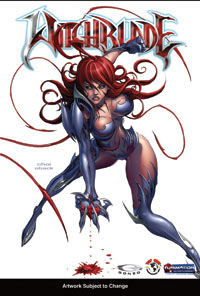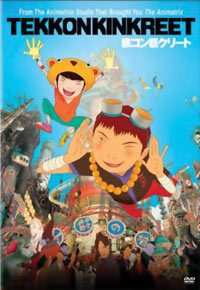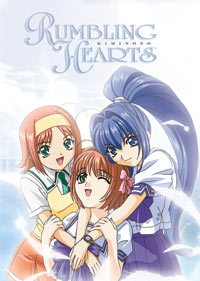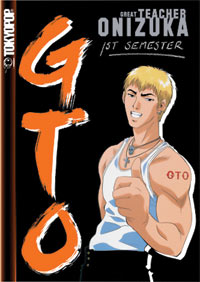Shelf Life
I Am the NHK
by Bamboo Dong,

Welcome to the NHK DVD 1
Rental
Tekkonkinkreet
Witchblade DVD 1
Perishable
Still nothing
Miscellaneous Boxsets
Rumbling Hearts DVD Boxset
Great Teacher Onizuka Season 1
Apparently, it's been around for much longer than I originally thought. Here's a ridiculous clip on YouTube from the 80s of a woman singing the theme, along with some great kids in serious 80s gear playing with video cameras. If you only watch one YouTube video in your life, that should be it. Here's a more recent commercial, one from Christmas 1995, one from 1985, one from 1984, and one from 1978. I sincerely hope this song gets stuck in your head, too, so we can bond through extreme suffering
Welcome to Shelf Life.
 Harking back to the first time I saw Otaku no Video, I have always loved anime series about fandom. To me, shows like Comic Party and Genshiken are the pinnacle of otaku self-reflection—they expose us as the weirdo nerds that we are, and give us the chance to laugh at ourselves and habits, while still giving us that tiny bit of Schadenfreuden when we say, “well at least I'm not that bad.”
Harking back to the first time I saw Otaku no Video, I have always loved anime series about fandom. To me, shows like Comic Party and Genshiken are the pinnacle of otaku self-reflection—they expose us as the weirdo nerds that we are, and give us the chance to laugh at ourselves and habits, while still giving us that tiny bit of Schadenfreuden when we say, “well at least I'm not that bad.”The newest gem to join these ranks is Welcome to the NHK, a quirky series being released by ADV. Sato is a hikikomori, a recluse that has withdrawn from society—since he dropped out of college, he hasn't been outside his apartment in four years. He doesn't even have the guts to go next door and tell his neighbor to turn down the magical girl anime song he's been playing on repeat. It's not his fault, though—he's convinced that he's victim to a conspiracy instrumented by the NHK broadcasting company, which brainwashes viewers with its cute anime shows.
Things change when he meets a girl named Misaki, who wants to help coax him out of his hikikomori ways. Refusing to admit to being a recluse, he tries to convince her that he stays at home because he's a game programmer, which leads to a promise that he'll show her one of his games in a month. This leads to the real meat of the story, which involves him and his anime-watching-neighbor scrambling to make a gal game.
The world of gal games and gal game players is, to me, hilarious. I love the seedy underbelly of our fandom that actually cuddles up to body pillows (okay, anime fans do this too), and I love all the stereotypes that they encompass. Watching the main characters run around Akihabara and go to maid cafes and shop at Tora no Ana makes me giddy inside, because I feel like I could actually be there. And really, we don't want to admit it, but we all know people who are just like that.
Welcome to the NHK is definitely good for laughs, but at the same time, it does shine a light on some parts of society, like the existence of hikikomori, which is a growing problem in Japan. Like many shows of this nature, though, its scenarios are a kind of double-jab, making fun of its audience, yet inviting them to laugh along. Personally, I love it, and I'm willing to bet money that most viewers who've spent a good amount of time in fandom will love it too. Every anime fan needs to see this.[TOP]
 Another volume 1 drifted into my hands lately, and it's one that I've been looking forward to—Witchblade. I was a little disturbed by the inside flap of the slipcase, though, because I couldn't figure out why Masane had three breasts. It wasn't until after four minutes of staring (actually, 3:47) that I realized that two of the breasts were actually just one breast, that were being squeezed by the really tight claws of her outfit. It can't possibly be comfortable running around with material digging into your bust and putting all of you weight on high-heel-blades, but Masane's so into destruction when she's transformed that I guess that extra pain must turn her on.
Another volume 1 drifted into my hands lately, and it's one that I've been looking forward to—Witchblade. I was a little disturbed by the inside flap of the slipcase, though, because I couldn't figure out why Masane had three breasts. It wasn't until after four minutes of staring (actually, 3:47) that I realized that two of the breasts were actually just one breast, that were being squeezed by the really tight claws of her outfit. It can't possibly be comfortable running around with material digging into your bust and putting all of you weight on high-heel-blades, but Masane's so into destruction when she's transformed that I guess that extra pain must turn her on.At this point, you're probably wondering why I spent so much time thinking about her outfit. Honestly, it's because I found it much more interesting than the actual disc, which can be summarized in three sentences. Masane and her “daughter” show up in Tokyo, only to be separated when Child Welfare takes the kid away. At the same time, Masane's Witchblade abilities are re-awakened, which captures the interest of some researchers who hire her to get rid of some unruly characters. She eventually agrees, is reunited with her daughter (with the help of the organization), and life goes on.
The story is very linear. This isn't a bad thing, but it also doesn't make for very exciting viewing. It does allow you to do other things while you're watching, but if you're driven to folding your socks, then it probably doesn't speak well of the series. None of the characters are particularly compelling, either, except for the daughter, who's pretty charming with her determination and gusto. The dynamic between her and Masane is interesting to watch, but nothing else really drives you to care about the characters.
Witchblade is the kind of series that would do really well on TV. It's very action-driven, and there's plenty of eye-candy, but it's something that doesn't really have too much replay value. I suppose you could just loop the scenes of Masane in her Witchblade outfit if you were a sick bastard, but aside from that, once you've seen it, you've pretty much got it. I could see it doing well as a “gateway” anime, though, so if you've got any friends you're trying to lure into anime, renting this may be a good move.[TOP]
 Next on my review list was the highly anticipated Tekkonkinkreet, licensed by Sony. Based on the manga, Black and White, by Taiyo Matsumoto, the film is especially notable for being directed by an American, Michael Arias. Also notable is the involvement of Studio 4°C, known for their stunning visual style and experimental works.
Next on my review list was the highly anticipated Tekkonkinkreet, licensed by Sony. Based on the manga, Black and White, by Taiyo Matsumoto, the film is especially notable for being directed by an American, Michael Arias. Also notable is the involvement of Studio 4°C, known for their stunning visual style and experimental works.The film is set in a sprawling urban mess called Treasure Town. What was once probably a glorious and prosperous neighborhood is now a dilapidated heap of concrete and steel. At the center are two feral children who call themselves Black and White, who refer to the place as “our town.” When a developer decides that he wants to wipe out the area and build an amusement park called Kiddie Kastle, he hires people to get rid of the people controlling the town, namely kids like Black and White.
While the story has a lot of potential, the resulting film is a bit of a mess. Visually, it's gorgeous, and the sometimes psychedelic scenes that pay homage to various artists are amazing to watch. Everything else, though, seems as though it was cut a bit short. The character development leaves much to be desired; while viewers get the gist of Black and White, and their different mental states, they're almost lost in all the other characters that Arias throws at the screen.
In fact, much of the movie feels lost in the sweeping piece that Arias and his fellow scriptwriter Anthony Weintraub have created. The dialogue is extremely verbose, there are too many unfinished concepts, and so much is going on that nothing really gets the depth that it deserves. Ultimately, it's a film that has more visual oomph than substance. It's definitely worth watching for the style and the creative approach that Arias has taken with the art direction, but it's a bit of a letdown because so much more could have been done.[TOP]
 If you missed all the drama and excitement of Rumbling Hearts, have no fear! Funimation has released a boxset version of this angst-drenched series. It's exactly the same packaging as you would've gotten had you bought them individually, but there's something to be said for not having to deal with end-of-volume cliff-hangers.
If you missed all the drama and excitement of Rumbling Hearts, have no fear! Funimation has released a boxset version of this angst-drenched series. It's exactly the same packaging as you would've gotten had you bought them individually, but there's something to be said for not having to deal with end-of-volume cliff-hangers.Rumbling Hearts is a series that I walked into with a lot of skepticism. However, that quickly disappeared as I was greeted with a bittersweet story about love and the cruelty of relationships. Above all else, the series is about human emotions and how strongly they can affect us. Crumbling relationships can destroy our worlds, while a simple smile can make our day, and Rumbling Hearts does its best to show how love can tear apart a group of friends.
The show starts off by introducing four high school friends, two guys, two girls, who have been together for quite some time. Two of them start a relationship, but everything is destroyed when the girl is injured in an accident and goes into a coma. Fast forward three years later, and viewers see that the guy is now dating his girl's best friend. There's enough drama and heartbreak there, but things only get more complicated when his former love wakes from her coma, not realizing that any time has passed.
It's not an overly complex story, but it's a tremendous catalyst for the characters' emotions. While things do get a bit over the top at times with all the anger and tears, you can't help but support the characters, because let's face it, the situation they're in really sucks. I always love a good dose of drama, and this is way better than any of the faux-reality junk on TV.[TOP]
 Funimation's also been releasing a lot of Tokyopop's older releases, which is really nice (I'm crossing my fingers for a better version of Marmalade Boy), as it makes them more easily accessible, since they're in boxset format. I'm particularly pleased that they've re-packaged the first season of GTO, one of the best school shows over made (though a case could be made that the live action version is superior).
Funimation's also been releasing a lot of Tokyopop's older releases, which is really nice (I'm crossing my fingers for a better version of Marmalade Boy), as it makes them more easily accessible, since they're in boxset format. I'm particularly pleased that they've re-packaged the first season of GTO, one of the best school shows over made (though a case could be made that the live action version is superior).An ex gang boss, Onizuka is the last guy you'd expect to be a high school teacher. His teaching methods are unconventional, and he has a real penchant for staring at high schooler ass, but he cares deeply for his students, and he's got enough guts and gusto to fill an entire courtyard. Assigned to teach a room full of delinquents and misfits, he eventually wins them over with his hardball tactics and his compassion.
It's getting pretty hard to find the original Tokyopop release of GTO, so this re-release comes at the perfect time. The episodes are a little formulaic, and get old after awhile, but the characters are really colorful and help contribute to the series' quirky sense of humor. Newcomers to the hobby may not remember this series, but it's definitely something that I'm happy I own, and it's something that I recommend seeing at least once. It's a lot like those movies where some nice lady goes to the hood and whips all the ghetto kids into shape, only it's a lot better, a lot fresher, and a lot funnier. If you want a series with a lot of heart, this is the way to go.[TOP]

This week's shelf obsessee is Aien, from the Netherlands. These shelves belong to her and her boyfriend, and feature European releases unknownst to us Yankees. I also spy My Little Ponies. Amazing.




All together now, let's sing the My Little Pony theme song!! And then ogle all her stuff. Mmm...
Got a collection you want to show off? Send your jpgs to shelflife at animenewsnetwork dot com!
discuss this in the forum (58 posts) |